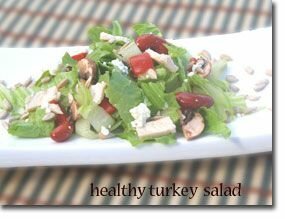Today's Recipe
If you don't know what to serve for dinner tonight ...
This turkey salad is quick, easy, and versatile. Use whatever vegetables you have on hand to create your own personal variation.
Healthy Turkey Salad

Prep and Cook Time: 10 minutes
Ingredients:
- 4 cups mixed greens
- 1/2 medium tomato, sliced
- 3 oz turkey breast, sliced
- 1/4 cup crimini mushrooms, sliced
- 3-1/2 TBS sunflower seeds
- 2/3 cup cooked kidney beans or canned (no BPA)
Printer Friendly Version of Healthy Turkey Salad
In-Depth Nutritional Profile for Healthy Turkey Salad
Healthy Food Tip
Can you help me better understand your nutrient rating system so that
I can make the best food choices? For example, I have heard that
almonds are rich in calcium, yet this fact is not highlighted in the
almonds or calcium write-ups.
Almonds do have a lot of calcium. According to the nutritional profile featured in the book, one-quarter cup of almonds contains 92 milligrams of calcium. Yet, the rating system for nutrient richness that we created for the World's Healthiest Foods website (www.whfoods.org) as well as my book is based not only on the amount of a nutrient that it contains but also the calories that it contains; this allows readers to know whether it would "cost" them a little or a lot of calories to attain the nutrients that are offered by the food.
To qualify to be noted as an excellent source of a specific nutrient, the food needed to feature 7.6 times the amount of nutrients for the calories it contained, to be a very good source it needed to provide 3.4 times the nutrients per calorie, and to be a good source it needed to provide 1.5 times the nutrients per calorie. Therefore, for example, foods with 7.6 mg or more of calcium per calorie are considered excellent sources; those with 3.4-7.6 mg of calcium per calorie are considered very good sources; and those with 1.5-3.4 mg of calcium per calorie are considered good sources.
As one-quarter cup of almonds contains 92 mg of calcium for 206 calories, they only provide 0.45 mg per calorie. Therefore according to our system, they don't qualify as even a good source of calcium, which is why they are not included in the nutrient richness chart or the best sources of calcium chart.
Now, that's not to say that calcium is not a wonderful feature provided by almonds; it's just that compared to other calcium-rich sources such as spinach that provides 10.6 mg of calcium per calorie, mustard greens that provides 8.9 mg/calorie, and yogurt that provides 5.2 mg/calorie, almonds do not provide nearly as much calcium for your caloric investment.
We hope that this helps to explain why almonds aren't singled out as a concentrated source of calcium. Using this almond-calcium example can also help you better understand the presentation of nutrient richness in the book so that you can make food choices based upon this important criterion.


No comments:
Post a Comment